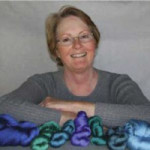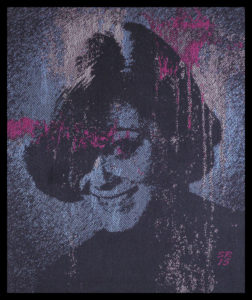Sandra began weaving in 1992, and has studied with national and international teachers. She has exhibited in high-end craft shows such as the Smithsonian and American Craft Council, and in juried and invitational exhibits.
Sandra has won awards (including the HGA and CW awards) at Convergence and local/regional weaving conferences, and also has won prizes in fine art exhibits for her jacquard designs.
She publishes articles in weaving journals, and maintains membership in several textile organizations.
Sandra’s studio work includes jacquard-woven wall hangings; and scarves, shawls, and table linens woven on a computer-assisted dobby loom. Her designs are inspired by the colors and textures of the natural world; or abstract forms.
From Shafts to Jacquard – Not a Big Leap
This seminar discusses Sandra’a process for using Adobe® Photoshop® to develop sets of satin weaves for use on a jacquard loom. Topics covered include:
1. Comparing the design space (a traditional weave draft) for a shaft loom and the design space for a loom that controls each warp thread independently of all the others.
- The shaft loom weave draft has a threading, treadling, and tie-up that work together to fill in the drawdown area – whether for 4 shafts or 40.
- A jacquard loom only has a drawdown, and the weaver is responsible for determining the action of every single thread, which can be intimidating.
2. Demonstrating the small set of Photoshop tools and concepts that the weaver needs to understand, such as layers, indexing, white transparent, visibility, etc.
3. Using those tools and concepts to develop a set of compatible satin structures that are capable of producing the visual effect of many hues from just a few thread colors.
- First, showing the development of a family of weaves for one warp color and one weft color, and applying those weaves to an image.
- Next, showing a family of weaves for one warp color and two weft colors, with all possible permutations, and applying those weaves to an image.
- Showing other families of weaves for more than two weft colors.
- Discussing the factors involved in choice of the size of the satin (5-end? 13- end?) based on thread density, number of wefts, and the purpose of the resulting cloth
4. Merging elements from different digital images into one design (the story behind Time Flies).
Fun with Interleaved Threadings
Sandra graciously agreed to present this CW2016 seminar again for all you who did not make it in last time.
Interleaving threads generate complex-looking designs and unbelievable color blending. Sandra will lead us through an explanation of interleaved threading, how weaving software can interleave two or more different files, the use of parallel threading (often called Eco), the difference between Shadow weave and Echo Weave, non-parallel threading and a few tips to ensure a successful interleave operation, as well as color and value choices for the warps and weft. She will also demonstrate the what-if game.


